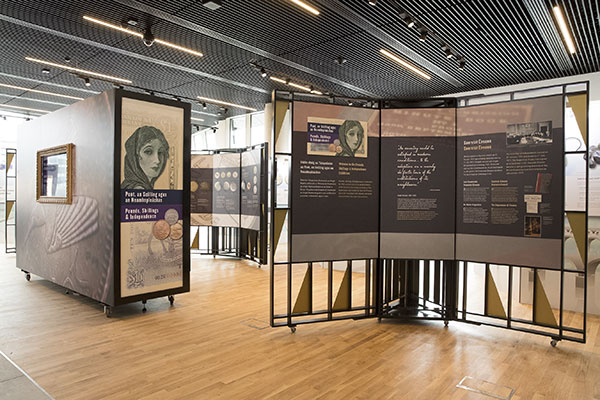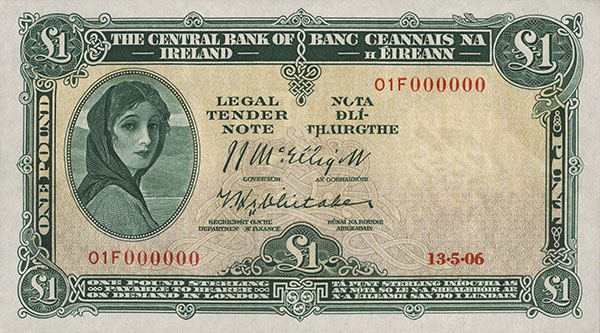Pounds, Shillings and Independence
Published in Issue 1 (January/February 2018), Reviews, Volume 26Central Bank Visitor Centre, North Wall Quay, Dublin 1
www.centralbank.ie, visitorcentre@centralbank.ie
By Tony Canavan

Above: The Pounds, Shillings and Independence exhibition in the Central Bank’s Visitor Centre in its new premises on North Wall Quay.
The new building that is now home to the Central Bank of Ireland is an impressive structure, apparently covered in gold leaf, overlooking the River Liffey. Unlike the old building in Dame Street, this one has a more friendly aspect and is positively welcoming to the public (although you can only get so far before you meet security checks). Part of this more welcoming attitude is the Visitor Centre on the ground floor. Recently housing an exhibition on the Euro, it also has a permanent exhibition on the history of our currency from the foundation of the Irish Free State. It would already seem to be a popular stop for locals and tourists alike, if the numbers there during my visit are anything to go by.
This exhibition opens with a short film outlining the creation of the new state, the decision to have its own distinct currency, and how that currency was designed. Interestingly, and perhaps uniquely, a poet chaired the committee to decide on the design of the new coinage—none other than W.B. Yeats, the Nobel laureate and Free State senator. This story is interesting in itself and the details are fleshed out in the exhibition. Incidentally, the benches that you sit on to watch the video are filled with shredded old Euro notes.
Using information panels, photographs and actual artefacts, it traces the story from the decision to have an independent currency after the Parker–Willis Commission. The idea of an Irish currency and a Central Bank was not universally welcomed. Some saw a central bank as only for countries with weak or unstable banking systems and believed that it would send out the wrong signals about independent Ireland. We learn that at that time there were two kinds of banknotes in Ireland. The fiduciary, or trust-based, note was the kind issued by the five main banks, while the secured banknote was guaranteed by the state (originally in actual gold). The establishment of the Central Bank of Ireland meant that it had a monopoly on issuing banknotes and so fiduciary notes disappeared.

Above: The original series of coins. Many Irish observers objected to the ‘beastly’ coins, and in particular to the inclusion of the sow and her litter on the ha’penny, which was thought to be too evocative of the ‘pig in the parlour’ depiction of the Irish.
Yeats’s committee decided on the denomination of the coinage (from farthing to a crown) and roughly what symbol should go on it—they would all have the harp on the obverse. Eight artists from across Europe and America submitted designs for the new coins. Masters of all eight submissions for the various denominations are displayed on a large panel nearby. It is interesting to see the different vision that each artist had and to decide for yourself which is the best. In the end, an English artist, Percy Metcalfe, won the competition. Despite the ostensible reasons for choosing Metcalfe, there was a sneaking suspicion that he won because his asking price, 45 guineas, was about one fifth of what the other artists were seeking. Nevertheless, it established him as a coin-designer and he subsequently did the same for a number of new states in the following years.
The section on the reactions to the new coinage would raise an eyebrow or two. Although Metcalfe’s coins did acquire iconic status and became accepted as epitomising the Irish spirit, at the time of their introduction there was some controversy. Some British politicians objected to the absence of the head of the king, who was still head of state, while many Irish observers objected to the ‘beastly’ coins, and in particular to the inclusion of the sow and her litter on the ha’penny, which was thought to be too evocative of the ‘pig in the parlour’ depiction of the Irish, a staple of British newspaper cartoons, examples of which are shown.

Above: In the original series of bank notes, artist John Lavery famously used his wife, Hazel (left), as the model for his image of Erin as a simple peasant girl.
The story of the pound notes of the new Central Bank, specimens of which are also on display, would appear not to be so interesting. There is, however, the involvement of the artist John Lavery, who provided the image for Erin as a simple peasant girl, which featured on all the banknotes. Famously, his American wife, Hazel, was his model for the portrait. Although the coins remained much the same, the banknotes changed design over the decades, and you can follow their evolution from the ploughman to the statesman. Ironically, the independent Irish currency was backed up by two accounts in the Bank of England. The Irish government lodged funds to cover the Irish money supply in the Legal Tender Note Fund and the Note Reserve Fund.
The design and substance of money—the actual coins and banknotes—is something we tend to take for granted, and the idea of an exhibition devoted to it may seem dull. Nevertheless, the story of Irish money is tied up with the legitimacy of the new Irish state and its development. This exhibition manages to make the story interesting by recounting the key events in the design of coins and notes, and lively through a good use of displays and information panels. It’s easily the kind of place where you could spend an hour learning about this aspect of Irish history.
Tony Canavan is editor of Books Ireland.
















